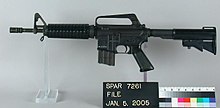
A carbine is a long gun that has a barrel shortened from its original length. Most modern carbines are rifles that are compact versions of a longer rifle or are rifles chambered for less powerful cartridges.

The M16 rifle is a family of military rifles adapted from the ArmaLite AR-15 rifle for the United States military. The original M16 rifle was a 5.56×45mm automatic rifle with a 20-round magazine.

The IMI Galil is a family of Israeli-made automatic rifles chambered for the 5.56×45mm NATO and 7.62×51mm NATO cartridges. Originally designed by Yisrael Galili and Yakov Lior in the late 1960s, the Galil was first produced by the state-owned Israel Military Industries and is now exported by the privatized Israel Weapon Industries.

The Colt AR-15 is a lightweight, magazine-fed, gas-operated semi-automatic rifle. It is a semi-automatic version of the M16 rifle sold for the civilian and law enforcement markets in the United States. The AR in AR-15 stands for ArmaLite rifle, after the company that developed it in the 1950s. Colt's Manufacturing Company currently owns the AR-15 trademark, which is used exclusively for its line of semi-automatic AR-15 rifles.

The IWINegev is a 5.56×45mm NATO light machine gun developed by Israel Weapon Industries (IWI), formerly Israel Military Industries Ltd. (IMI).

A flash suppressor, also known as a flash guard, flash eliminator, flash hider, or flash cone, is a muzzle device attached to the muzzle of a rifle that reduces its visible signature while firing by cooling or dispersing the burning gases that exit the muzzle, a phenomenon typical of carbine-length weapons. Its primary intent is to reduce the chances that the shooter will be blinded in low-light shooting conditions. Contrary to popular belief, it is only a minor secondary benefit if a flash suppressor reduces the intensity of the flash visible to the enemy.

The Vietnam War involved the People's Army of Vietnam (PAVN) or North Vietnamese Army (NVA), National Liberation Front for South Vietnam (NLF) or Viet Cong (VC), and the armed forces of the People's Liberation Army (PLA), Army of the Republic of Vietnam (ARVN), United States Armed Forces, Republic of Korea Armed Forces, Armed Forces of the Philippines, Royal Thai Armed Forces, Australian Defence Force, and New Zealand Defence Force, with a variety of irregular troops.
The Springfield Armory M1A is a semi-automatic rifle made by Springfield Armory, Inc., beginning in 1971, based on the M14 rifle, for the civilian and law enforcement markets in the United States. "M1A" is a proprietary name for Springfield Armory's M14-pattern rifle. Early M1A rifles were built with surplus G.I. parts until Springfield Armory, Inc. began manufacturing their own. Robert Reese bought Springfield Armory from Elmer Ballance, and moved the manufacturing to Geneseo Ill in 1974.
The La France M16K is an M16 rifle modified by the company La France Specialties, which among with other firearm-related activities, convert common military weapons into more compact configurations typically for law enforcement and special forces use.

The ArmaLite AR-15 is a select-fire, gas-operated, air-cooled, magazine-fed rifle manufactured in the United States between 1959 and 1964. Designed by American gun manufacturer ArmaLite in 1956, it was based on its AR-10 rifle. The ArmaLite AR-15 was designed to be a lightweight rifle and to fire a new high-velocity, lightweight, small-caliber cartridge to allow infantrymen to carry more ammunition.

The Colt Automatic Rifle-15 or CAR-15 is a family of M16 rifle–based firearms marketed by Colt in the 1960s and early 1970s. However, the term "CAR-15" is most commonly associated with the Colt Commando ; these select-fire carbines have ultrashort 10.5-inch (270 mm) and 11.5-inch (290 mm) barrels with over-sized flash suppressors.
The Z-M LR-300 is an American rifle designed by gunsmith Allan Zitta and manufactured by Z-M Weapons. The model name LR-300 stands for Light Rifle and 300 is for 300 meters, which is regarded by the manufacturer as the effective range of the rifle with a standard 55 gr (3.6 g) FMJ bullet. The design is based on the AR-15, M16 and C7 rifles, but has a unique semi-direct gas impingement system and a folding stock option.

The Close Quarter Battle Receiver (CQBR) is a replacement upper receiver for the M4A1 Carbine, developed by the US Navy.

The M231 Firing Port Weapon (FPW) is an adapted version of the M16 assault rifle for shooting from firing ports on the M2 Bradley. The M16, standard infantry weapon of the time, was too long for use in a "buttoned up" APC, so the FPW was developed to provide a suitable weapon for this role. Designed by the Rock Island Arsenal, the M231 FPW remains in service. All but the rear two firing ports on the Bradley have been removed.
The Colt Automatic Rifle or Colt Light Machine Gun is a 5.56 mm NATO, open-bolt, full-automatic-only firearm developed by Colt Defense. It is based on the M16A2/A4, and has a distinctive squared-off handguard, vertical grip, carrying handle and integrated bipod.
The Colt Machine Gun or CMG was an open bolt belt-fed machine gun that fires 5.56×45mm cartridges designed by Colt Manufacturing Company in 1965. Colt hastily developed the CMG-1 to complement the CAR-15, a Colt branding of the M16 rifle, so that Colt might offer both of them as an alternative to the Stoner 63 weapons system. It failed to achieve any sales, and was replaced by the Colt CMG-2, which also failed to achieve any sales. The CMG-3 was a 7.62×51mm NATO version that failed as well.

The Colt 9mm SMG, also known as the Colt Model 635 or Colt M635, is a 9×19mm Parabellum submachine gun manufactured by Colt, based on the M16 rifle.

The Colt 933 is a compact carbine based on the AR-15, M16 rifle and M4 Carbine produced by Colt starting in 1995. Due to its compact size, the short-barreled Colt 933 continues to be used by various US Special Forces and by some foreign forces, including Israeli Special Forces.


















